You come upon the elephants slowly—glimpsed while walking down a city street as flickers of color against a building, or as strips of light velcroed to wet air—and then very quickly. When they emerge fully, they loom enormous from within their video loops. They transform urban scenes and dwarf human inhabitants, appearing both incongruous and inevitable. Of course an elephant flickers across an apartment façade. Why not? As I rounded a Bushwick corner at 10 pm on a Sunday evening last November, I saw beneath the likeness of a huge, swaying elephant its keeper, the photographer Colleen Plumb. She bounced vaguely in the below-freezing air, watching her elephants as they mooned everyone in eyesight, which was, admittedly, not very many people.
She alternately huffed on her hands and approached anyone who appeared at all interested in speaking with her. A pair of kids had leaned out of a window above her earlier, shouting down questions before an adult arm slammed the sash shut with the authoritative clap of a strictly enforced bedtime. Now two twentysomething men slowed their walking pace and eventually stopped as they turned to watch the projection.
Number one question asked of Plumb as she projects elephants in cities around the world: Do you have permission to do this? Number one answer: Not really. She explained to the men that no, no one had invited her to project her elephants here, but no one appeared to mind, either. Her hands moved throughout. Plumb is a master of the enthusiastically meandering sentence, and uses her body—medium height, 47 years old, topped with blonde hair—as punctuation. On this cold evening, her movement also warmed her. She leaned and swayed as she began to tell the men why elephants in captivity rock back and forth. “So, it’s called stereotypic behavior . . . ” she explained, shouting over the noise of her generator, as a bodega-sized Schottzie the elephant swung back and forth, back and forth, in an anxiety-inducing coil of constant movement.
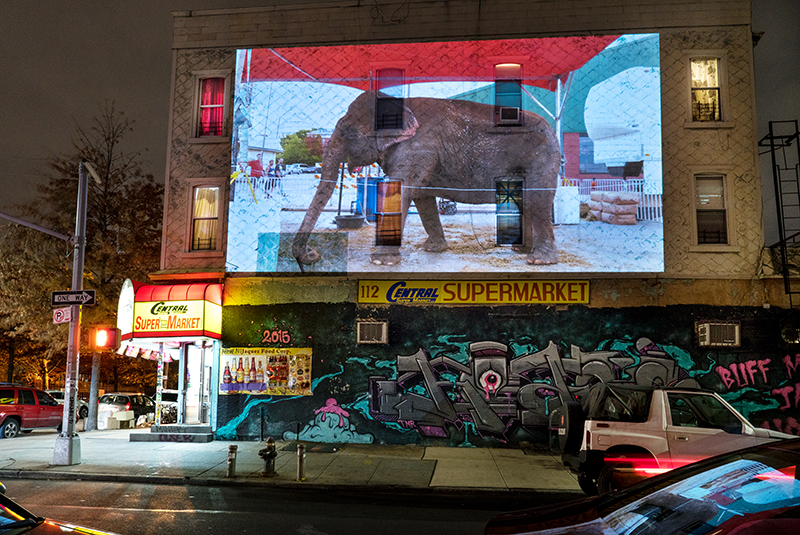 Cindy (Peru, Indiana) at Central Supermarket, Bushwick, Brooklyn, New York, 2016. Courtesy of Colleen Plumb.
Cindy (Peru, Indiana) at Central Supermarket, Bushwick, Brooklyn, New York, 2016. Courtesy of Colleen Plumb.
Plumb’s elephants are literally many, but in video they appear as one. For her multimedia project, Thirty Times a Minute, she filmed video of their rocking and swaying, bobbing their heads and swinging their trunks, pacing in their cages or seeming almost to dance. She created a video loop of this stereotypic behavior, the pachyderm’s reaction to the constraints of captivity—in the wild, elephants walk up to 50 miles a day—and named it after an elephant’s heart beat. Circus handlers have been known to explain stereotypic behavior to curious crowds by crediting it to an elephant’s keeping time with his pulse.
Though Plumb has been primarily a print photographer—her photos pop up in Chicago’s Museum of Contemporary Photography and the Milwaukee Art Museum, on the New York Times’ Lens blog and Time’s LightBox series—the heart of Thirty Times a Minute lived within these public projections. She loosed them on cities and ecosystems across the country and the world: gently swaying elephants above the river in Chicago, her hometown, or across an Oregon waterfall, or, last summer, against a Parisian apartment building on a Saturday night, when her projection’s light competed with the twinkling windows of the half-dozen dinner parties. She packed up quickly to evade the notoriously strict police as they’d rolled up in front of the building. She’d shown the video, too, at the Portland Art Museum and Miami’s Screening Room, but more often than not she’d undertaken these projections independently. Thirty Times was “painfully self-funded,” she told me.
New York, the most densely populated city in the United States by a factor of nearly two, had intimidated Plumb for its proliferation of police and right angles, the thickness of its art infrastructure and buildings too high for a projector to reach. But this weekend, she’d come to the city for the first time to project as a prelude to a multi-day installation she’d been invited to devise for The Photography Show, the annual fair put on by the Association of International Photographic Art Dealers. The gig—projections across the fair’s façade on Pier 94 for the duration of the March event—would be Plumb’s biggest presentation yet. She’d have money for a projector that could offer some competition to low daylight, and she’d have an audience on a thus-far-unachieved scale.
Projecting Thirty Times a Minute, 2014-2016, on-going from Colleen Plumb on Vimeo.
She’d also recently been contacted by an animal-rights organization, the Nonhuman Rights Project, working in conjunction with the attorney Steven Wise. Lawyers wanted to use her videos as evidence in an upcoming habeas corpus case they’d file on behalf of a trio of mistreated circus elephants. The NhRP had filed suits before—they’d just been given a New York court date in March for the appeal of a lower court’s denial of petitions for writs of habeas corpus on behalf of two captive chimpanzees, Kiko and Tommy—and now Wise’s team was trawling for evidence to support a similar case for three elephants.
Plumb stood on the brink of something, though what was unclear. “It’s so hokey,” she’d told me the week before she’d come to New York, “but the elephants just need to be there before AIPAD.” She believed in the importance of their being seen, the psychic freeing of these gargantuan animals in areas densely populated by humans. As an artist, her primary goal was interruption: to inject an entity into the urban fabric that definitively did not belong, to, as she put it, “puncture social individuality.”
And now here they were. Plumb had already projected against the industrial underside of the Brooklyn Bridge—in 1884, the year after its construction, P.T. Barnum had walked 21 elephants across the bridge to demonstrate its strength. She’d projected in Central Park’s Bethesda Terrace the night before. The scurry of rats and sweep of bats punctuated the thrum of the projector as the elephants moved around the arcade. First the video showed a huge elephant, its legs tangled in the baroque arches as it swayed, and then a different animal in a different zoo rocked in the left corner, the size of my shadow, so close I could touch it. The elegance of the terrace’s construction, its richly painted tiles and florid columns, crackled beneath Plumb’s video.
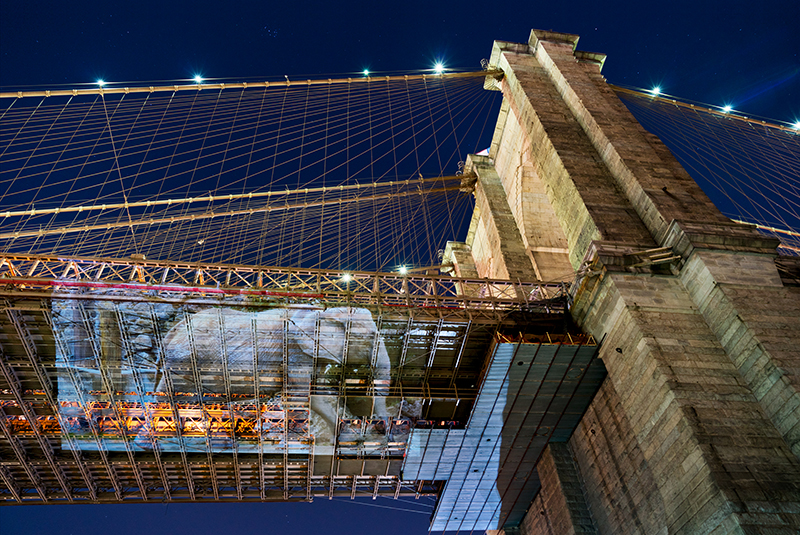 Drumbo (Vienna, Austria) at Brooklyn Bridge, New York City, 2016. Courtesy of Colleen Plumb.
Drumbo (Vienna, Austria) at Brooklyn Bridge, New York City, 2016. Courtesy of Colleen Plumb.
Here, now, in Bushwick, the elephants on the three-story apartment building were farther away, pacing just above a bodega’s awning, its advertisements for Corona, Modelo, Pacifico, and a first floor covered in teal, pink, purple, and black graffiti. In one clip, an elephant swayed his trunk against the backlit red curtains of an apartment as if nosing his way inside. The streetlight turned red. Sneakers hung over the lamppost on the corner, yellowish against the bruisy night sky. The playground across the street was empty as firm little snowflakes drifted from the sky, and when the projection ended and the black title screen shot across the building and the eight apartment windows emerged from background to foreground, I went into the bodega for a snack. Inside the brightly lit shop, the attendant warbled operatically to a Norteño ballad. He did not stop singing as I handed him cash, did not stop as he handed me change.
When I emerged, Plumb was attending to her cords and tripod. “See?” she said brightly as she turned toward me. “It’s a monument to what’s about to go extinct here, too. The elephants, but also the corner grocery mart.”
![]()
Colleen Plumb’s artwork, according to her website, explores “the way animals in captivity function as symbols of persistent colonial thinking,” the normalization of the idea that humans should strive to dominate nature, and the way consumption has replaced curiosity. This focus places it within a particularly rowdy stream of contemporary art. All across the gallery rosters and institutional shows, in magazines and catalogues, a menagerie emerges. The trend is neither brand new nor edgy, per se—see: a New York Times article, published in 2000 under the headline “Animals Have Taken Over Art, and Art Wonders Why;” the magazine Antennae: The Journal of Nature in Visual Culture, celebrating its tenth year this spring; or coverage of the German art exhibition documenta 13 in 2012, nicknamed “dogumenta” for the proliferation of live animals in its artworks. But the best recent art about animals reveals specific new overlaps.
Rather than using animals a la Damien Hirst, who preferred his sharks and sheep dead and pickled, or Joseph Beuys, who lectured to a dead rabbit and locked himself for three days in a gallery room with a live coyote, these more recent pieces pull viewers toward the condition of captivity itself in lush, immersive conceptual works. Some use technology—like Plumb’s projections or Duke Riley’s 2016 “Fly By Night,” for which 2,000 pigeons dashed across a plush evening sky above New York’s East River wearing LED-studded anklets—to mimic and build upon the sense of intimidation and wonder humans feel when looking at animals. Dana Sherwood constructs animal feasts shaped like elaborate human meals—a molded terrine of jellied spam, beef, hot dogs, and marrow bones for coyotes, or layer cakes made of birdseed—and places them out in meticulously-researched habitats to be devoured by the local fauna as a hidden video camera records.
Others plunge humans themselves into strange and often uncomfortable spaces, as in Finnish artist Terike Haapoja’s collaborations with writer Laura Gustafsson, “The Museum of the History of Cattle,” an elaborate vista of human history from the perspective of cows, or Mark Dion’s “bird libraries,” careful, immersive assemblages featuring trees, hunting and ornithology paraphernalia, books, and 20 or so live birds.
In their own ways, these artists and many others have responded to the shift in the last half-century in the human understanding of what animals think, feel, and know. They are far from alone: policies are shifting, too. Recent developments in animal welfare include the closure of SeaWorld’s orca-breeding program, the end of the NIH’s support for “invasive research” on chimpanzees, the shuttering of the 146 year-old Ringling Bros. and Barnum & Bailey Circus, and zoos around the country pledging to discontinue elephant programs when their current elephants die.
Occasionally, art and policy run in tandem, as in the case of Plumb and the Nonhuman Rights Project. Sometimes, too, the two aims collide. When they do, the animals themselves seem to perform an allegorical role, standing in for larger political arguments. Last winter, choreographer-slash-conceptual artist Ann Carlson’s “Doggie Hamlet”—a dance featuring sheep, humans, and a central dog—found itself at the center of the ever-recurring public debate about government funding for the arts. “Actors in federally funded show yell and run at sheep in field for ‘postmodern dance,’” read the headline on the Washington Free Beacon’s December article. In September, animal-rights activists protested the inclusion of three works in the Guggenheim’s autumn show of art from China: two videos of past performances—one in which American pit bulls struggled toward one another but were not allowed to fight, and another in which two pigs mated in front of a live audience—and one live work of art featuring insects. The wording of the petition on change.com, signed by upwards of 800,000 people to date, held a not-so-veiled implication of perceived Chinese mores: “animal cruelty holds no place in art in the United States, nor should it anywhere in the world.” The museum pulled the pieces from the show.
Really, though, these developments notwithstanding, very little has changed about the essential structure of human-nonhuman animal relations. This is what Steven Wise hopes to shift. He aims to establish personhood for highly intelligent animals using the writ of habeas corpus: not humanity, but legal personhood, the difference between an inert “thing” that can be owned and traded and a “person” entitled to the fundamental right of bodily liberty. As the field of animal law grows—Wise knew of only two other animal-law classes in the country when he began to teach on the subject at Vermont Law School in 1990—he has emerged as a bit of a celebrity. He has lectured at a TED Conference and Harvard Law School, been the subject of magazine profiles and an HBO documentary that premiered in February. Of it, A.O. Scott wrote, “it is hard to watch Unlocking the Cage without being somewhat swayed by the arguments—or at least impressed by the sincerity—of Steven Wise.”
As February scrolled into March, Plumb put the final touches on a new video and installation plan for AIPAD, Path Infinitum—the new video included other animals she’d filmed at zoos, tigers and otters and badgers and macaws, and the technical specs of the facade posed fresh challenges. On their end, Wise and his legal team prepared for court. Before mounting his case on behalf of the circus elephants, he would speak for two chimpanzees who’d been central to his lawsuits for years. It would be his sixth time appearing in a New York courtroom on behalf of one of a series of primates; this was his team’s first appeal on behalf of Kiko and Tommy. Wise had initially brought lawsuits for the two chimpanzees, owned by two different humans and held in dire cages in different places in New York state, in 2013.
On March 16th he presented his argument to a courtroom through which, NhRP executive director Kevin Schneider later told me, a sense of aggravation bordering on contempt wafted. On appeal, no lawyers took up the opposing side; this put the five judges themselves in the position of interrogating Wise’s argument. The nut of his case as he has presented it since 2013 is this: If a corporation can be a legal “person”—if our legal system grants bodily rights to an infant and a comatose human, who similarly cannot bear legal duties, and if a sacred river in New Zealand and a chimpanzee named Cecilia in Argentina have been granted the rights of personhood—why not an American chimpanzee or an elephant, an entity objectively more sentient than an association of profit motives?
![]()
Two weeks later, a 15-foot macaw sat perkily on what appeared to be the top of the automatic sliding doors to Manhattan’s Pier 94. He did not intend to look judgmental. Still, he did. Observed from the West Side Highway, the macaw stared down as a suited gallery staffer joked with a laughing woman. From the inside of the fair, the macaw appeared to cock his head quizzically at a man who paused near the entrance to peck on his cell phone. From the inside, where the projector was mounted, the structure that really held the macaw aloft was apparent: a brown concrete branch, very fake yet very detailed, appeared in relief against the black metal structure.
Throughout the rest of the video, giraffes licked the walls of their blue enclosures, a reddish-brown elephant swayed in the sun, a tiger paced lankily, a polar bear rubbed his rump rhythmically against his stone ‘habitat.’ The images persisted long enough that a continuous viewer could find echoes in color, movement, and scene; the differences in habitat, similarities in movement. Though sunshine had the effect of dulling the projection and superimposing zooming yellow taxis and midtown skyscrapers, Plumb had affixed ambient light-rejecting film to the glass windows—procured from a company in Houston at cost because, Plumb told me, “the guy loves whales”—so that even in the afternoon light, something of the animals remained visible. In the rain, every color popped as harnessed ponies flicked their tails while walking in circles above fairgoers’ umbrellas. Regardless of the weather, the fading light of every day worked like developing fluid on Plumb’s projection. As the video got brighter and brighter, fairgoers had to walk straight into the image itself.
plumb.aipad.video from Colleen Plumb on Vimeo.
Throughout the fair’s duration over the last few days of March, Plumb enjoyed watching the macaw watch the attendees, who either watched or did not watch the animals on the façade above and around them. “It kind of underscored what was happening in the video itself,” she told me approvingly. “The bizarre situation that the animals are in became real life—none of it fit together. People waiting for their Ubers with this drama going on behind them was cool.” She observed people taking quiet moments after the intense buzz of the fair inside, and how the door they exited through serendipitously interacted with the film, sliding open to engulf a marching tiger. “Watch out,” one man exclaimed, “that tiger’s gonna bite you!” Another stood and posed for a photo with his arms outstretched in parallel with the flying vulture on the doors.
“It’s hard to deny it,” AIPAD director Catherine Edelman told me of Plumb’s work. “It’s easy to walk past a photograph that has a monkey chained to a chair, an elephant with its trunk down or any other symbol of distress. It’s easy to walk by. We do it daily. We flip the page on the newspaper. But when you have to interact with it . . . it’s gonna be powerful.”
Plumb’s work differed from most representations of animals in the photography inside of the show. Unlike nature photography, which often aspires to immediacy and renders the photographer invisible, Plumb aims to highlight rather than compress the distance between viewer and animal. Like Garry Winogrand’s photographs of zoo animals, her videos emphasize how seen the animals are—the consequences of that seen-ness, the human complicity in it, what such objectification means.
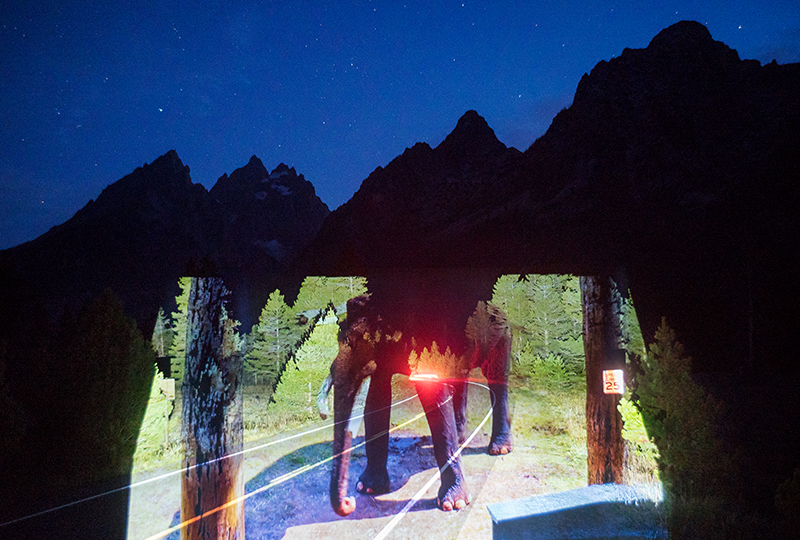 Rex (Oklahoma City, Oklahoma) at Grand Teton National Park, Wyoming, 2015. Courtesy of Colleen Plumb.
Rex (Oklahoma City, Oklahoma) at Grand Teton National Park, Wyoming, 2015. Courtesy of Colleen Plumb.
Because the specific animal is rarely the point; its captivity comes to eclipse the reality of the animal itself. In Thirty Times A Minute, the neurosis of watching Plumb, behind her camera, watch the animals—and then watching the animals move across a human landscape, within their human-constructed constraints—can be almost physically uncomfortable. In Path Infinitum, the melancholy inherent to zoos became overt when presented in a more restrained environment. The tiger paced under unnatural light, and in the frame below him, prairie grasses swayed: where the tiger yearned to be.
Different locations imposed different scrims of meaning to Plumb’s projections, whether philosophical or moral or historical: Inserted into the urban fabric, unpredictable, sudden, human structures appear newly strange. As I’d stood outside of the bodega on that anonymous street corner in Bushwick in November, I’d felt both the predictable wonder at the size and elegance of even an unhappy elephant and also a heightened awareness of my surroundings. The varied layers teased apart and I noticed everything else: the way the man in the bodega sang, the crisp snowflakes that fluttered between the elephant and me, the sneakers hanging off a lamppost, the stiff pulsing of my cold hands in my coat pockets. The elephant was central to the scene, swinging his trunk across the windows of the apartment building, but also not.
![]()
John Berger, in his essay “Why Look at Animals?” describes the difference between the animal gaze and the human gaze—that is, an animal looking at a human versus two humans observing one another—as one defined by the impossibility of communication. “The existence of language allows that at least one of them, if not both mutually, is confirmed by the other,” Berger writes. “Language allows men to reckon with each other as with themselves.”
Anthropomorphizing, animating, and representing compresses this distance for a moment. But there’s no erasing the distance between a live animal and a human. The cat snuggling in my bed, kissed on the nose, nuzzled in the soft spot between the ears, still has claws and an unknowable set of emotions and reactions to my touch. My cat, who serves no purpose other than existing as an animal in my house—setting aside the history and ethics of domesticated animals—can’t dictate any preferences to me. The impossibility of the human-animal reckoning unfurls: it is personal, philosophical, scientific, ethical, historical, political, empathetic.
On a legal level, this fact haunts the foundation of both Wise’s petition and the court’s rejection of it. That chimpanzees like Kiko and Tommy have been taught to speak sign language but cannot advocate for themselves within a human legal system positions them as wards of the human state, the Nonhuman Rights Project argues, like an adult in a coma or the severely mentally ill. The court, in denying them the right of habeas corpus, found that, “[U]nlike human beings, chimpanzees cannot bear any legal duties, submit to societal responsibilities or be held legally accountable for their actions.” Even us humans, the subtext seemed to say, this is all we’ve got: language, legal duties, societal responsibility, accountability.
“The impossibility of the human-animal reckoning unfurls: it is personal, philosophical, scientific, ethical, historical, political, empathetic.”
On an artistic level, the empathetic tease of nonhuman animals, the barrier between us and them, has inspired human mark-making since humans first drew symbols on the walls of caves. Humans are animal and we are other. We possess knowledge that other creatures do not but lack their instincts. Humans make computers and airplanes; many nonhuman animals can sense an earthquake long before it occurs. Humans weigh moral and ethical concerns; a Clark’s nutcracker can remember where it has stored 2,500 seed caches over the winter season. “Animals came from over the horizon,” Berger writes. “They belonged there and here. Likewise they were mortal and immortal. An animal’s blood flowed like human blood, but its species was undying and each lion was Lion, each ox was Ox. This—maybe the first existential dualism—was reflected in the treatment of animals. They were subjected and worshiped, bred and sacrificed.”
Now, after the industrial age and its consequences, deep in the information age, as think-pieces ask what comes next, the surge in recent animal-focused artwork—immersive and urban, skating as much of it does around the striving for and impossibility of control, interacting as it may with activism while evading crusading aims—lives in that duality.
Indeed, the varied intents of activism and art twist around each other as they shift and grow. In 2000, Mark Dion wrote what he called “Some Notes towards a Manifesto for Artists Working with or about the Living World,” published in a catalogue for the Serpentine Gallery exhibit The Greenhouse Effect. In it, he anticipated this interweaving and defended the essential difference between the artistic and activist pursuits.
“We are not living in a simple age and as artists of the time our work reveals complex contradictions between science and art, between empiricism and the idea, between nature and technology and between aesthetic conventions and novel forms of visualization,” he wrote. “Our goals vary. While some may wish to dissolve the contradictions in our social relations to the natural world, others may be interested in analyzing or highlighting them.”
![]()
The Nonhuman Rights Project expected a ruling on their appeal in 5 to 8 weeks, but April stretched into May and even June before the court made public its decision. During those months, the bubble and fizz of initial attention Plumb had received at AIPAD had settled and solidified. An independent curator focusing on environment and sustainability had gotten in touch, the Ryan Lee Gallery in New York had mentioned showing her video work in their High Line-facing window, the art publisher Radius Books had asked her to submit a proposal for a Thirty Times a Minute book, and Edelman invited Plumb to participate in a three-person show at her eponymous Chicago gallery. A show with Edelman, who’s shown photographers from Nan Goldin to Annie Liebovitz, had long been a goal of Plumb’s.
“It’s a dream,” Plumb said to me on the phone a month before the show’s opening. She would project a version of Path Infinitum and three light boxes with bright transparencies of Thirty Times A Minute projections. Her work would appear alongside Omar Imam’s photographs of Syrian refugees, surreal and elegiac black and white images shot at camps across Lebanon, and abstract work by Garrett O. Hansen, who collects the remains of bullet-eroded cardboard backings at Kentucky shooting ranges for an abstract series on gun violence.
Plumb had postponed a trip to Florida’s Center for Great Apes, where she’d hoped to film the primates for a future project, to prepare for the show. She would stretch her video across the bottom half of Edelman’s gallery window, two panes alongside one another. She’d been tweaking, and tweaking, and tweaking the video a little more, hoping to capture something of the satisfaction of paging through a book in the side-by-side imagery. She’d been submerged in the sequencing when the results of the Nonhuman Rights Project’s hearing came down last week.
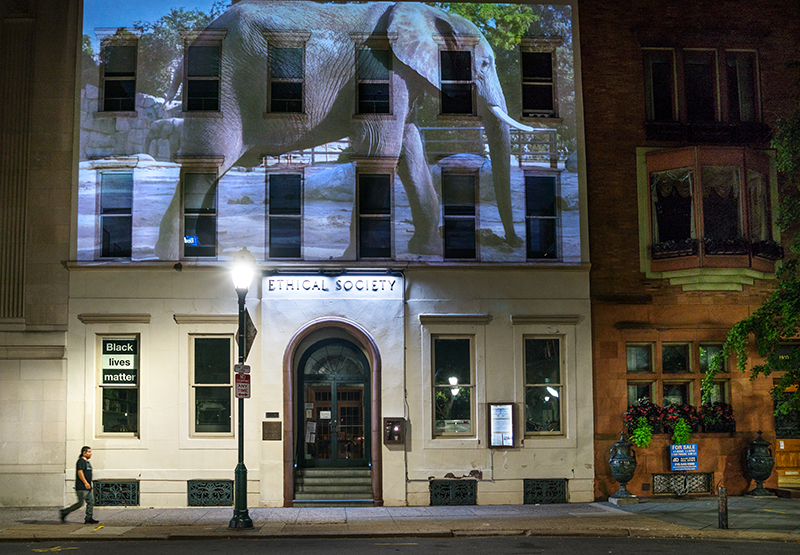 Tembo (Berlin, Germany) at Ethical Society, Philadelphia, PA, 2017. Courtesy of Colleen Plumb.
Tembo (Berlin, Germany) at Ethical Society, Philadelphia, PA, 2017. Courtesy of Colleen Plumb.
The appeal’s ruling, which upheld the lower court’s decision, possessed a terse tone, even in the naturally blunt language of legal proceedings: “Any new expert testimony/affidavits cannot be said to be in response to or counter to the reasoning underlying the [previous] decision,” it read. Parallels drawn to corporate personhood were misplaced as “such laws are referenced to humans or individuals in a human community;” the New Zealand river treated as a legal person that owns its riverbed, used to demonstrate that “person” need not mean “human,” was not relevant to U.S. law, and “certainly is of no guidance to the entitlement of habeas relief by nonhumans in New York.”
Most importantly, perhaps, the court pointed to a the central contradiction: that since his team did not challenge the legality of Tommy and Kiko’s captivity—Wise was not proposing that the chimpanzees be set free in the streets of Albany and Niagara Falls, where they are currently kept—but rather sought their transfer to a different, more humane facility, the writ of habeas corpus didn’t really apply. “While petitioner’s avowed mission is certainly laudable, the according of any fundamental legal rights to animals, including entitlement to habeas relief, is an issue better suited to the legislative process,” the ruling concluded. The judges seemed to stumble around one essential contradiction: that the codification in human law of rights for nonhumans relies on the very exceptionalism it hopes to refute.
The Nonhuman Rights prepared a point-by-point response to the ruling. “It stands out to us like a sore thumb that while they dispense with the New Zealand case, they ignore the case of Cecilia,” Schneider told me. The binary of “good captivity” and “bad captivity” is flawed, yes, he said, but what else is there? Regardless, the elephant case loomed. On November 14, Wise filed a writ of habeas corpus petition in Connecticut on behalf of three elephants in a traveling circus. “We’re very interested to see how these arguments play out in another state,” Schneider said. This time, he hoped, Wise would face another attorney, the better to flesh out the ideas behind the case. He wanted, too, to find ways to garner more public attention so as to “create more pressure points,” he said.
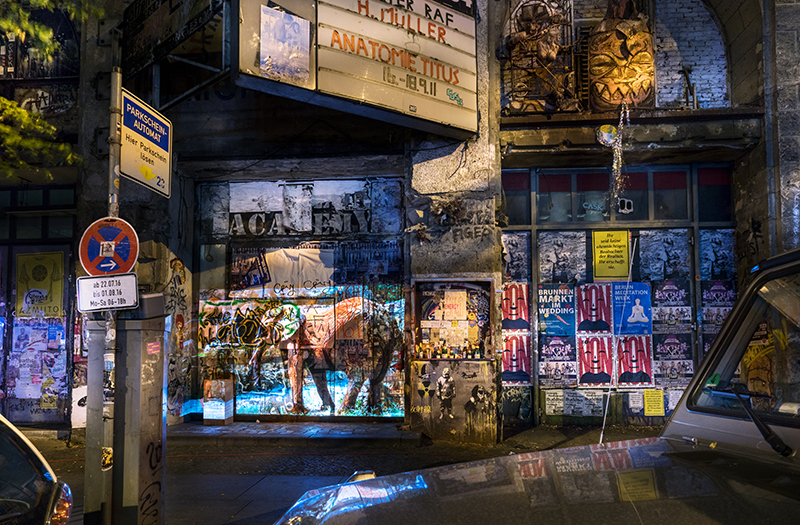 Joy (Greenville, South Carolina) at Kunsthaus Tacheles, Berlin, Germany, 2016. Courtesy of Colleen Plumb.
Joy (Greenville, South Carolina) at Kunsthaus Tacheles, Berlin, Germany, 2016. Courtesy of Colleen Plumb.
As he spoke, I thought of Plumb’s belief in the importance of being seen, the dignity inherent to acknowledgement and the calculus of wrenching individualized attention from within human systems, imperfect as they may be. Only a half-dozen people had observed elephants that evening in Bushwick, but that had seemed, to me, beside the point. Plumb had found a fresh way to set the human and natural worlds against one another, separating layers of viewership and complicity and constraint as light separates through a prism. She’d confronted each person walking past or through the projection, or falling asleep with a lurking elephant outside, with the sudden opportunity to pull the experience into their own lives. In this she had found a reverberation of the wildness to which her elephants would never return.
As for her, Plumb’s summer show went off without a hitch. Radius approved her book, which will hit shelves in 2018. And she will return to the public scale again, and maybe even bigger: a scale that dwarfs the senses, that screams at being reached out towards, that shoves its environment into submission. First, the gallery window, the lightboxes, the book. Eventually, the skyscrapers.



